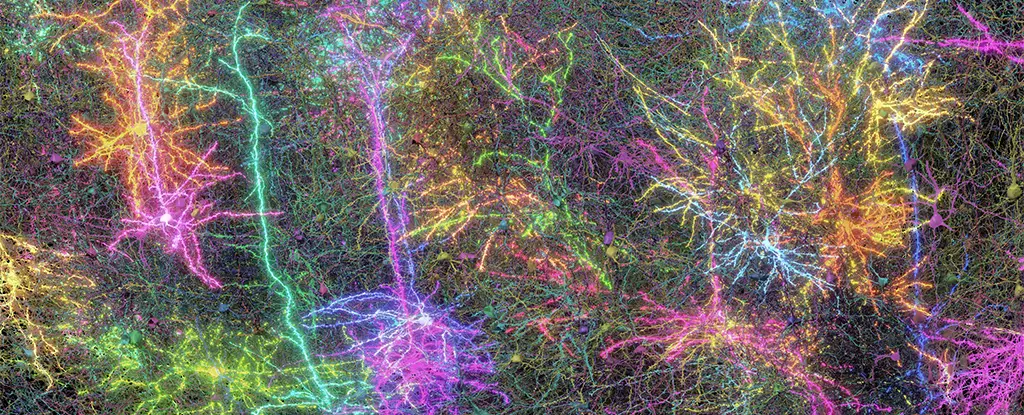To dive into the depths of the human brain is akin to embarking on an expedition into the farthest corners of the universe. There, amid galaxies and stars, we find our own cerebral cosmos—a dynamic, intricate network that has eluded full comprehension for centuries. Recent research has made significant strides in illuminating this mystery, shedding light on the connections within the brain using a mouse model as a gleaming reference. The study, taking nearly a decade and involving over 150 experts from elite institutions, has crafted a monumental achievement: the most intricate mapping of a mammalian brain ever attempted.
The sheer scale of this endeavor is staggering. Researchers painstakingly mapped a minuscule portion of a mouse brain, limited to an area comparable to an individual grain of sand. Yet, within that confined locale, they decoded over 84,000 neurons and nearly a half-billion synaptic connections, spanning an astonishing 5.4 kilometers of neural pathways. This endeavor was about more than just raw data; it was a quest to understand how emotion, cognition, and perception spring from a labyrinthine network of biological circuitry.
The Convergence of Structure and Function
Andreas Tolias, a leading neuroscientist, aptly summarizes the significance of this research by highlighting how it marries the structure and function of the brain. The bright, digital tyranny of artificial intelligence struggles to mimic the fluidity and nuanced decision-making capabilities of our brains. This research brings us closer to mapping a connectome—a detailed architectural blueprint of neural connections. By blending advanced AI with traditional scientific methods, the team embarked on an ambitious journey into the depths of neuroanatomy, exploring both the shape and function of neural connections.
Unlike previous projects that tackled simpler nervous systems, this research sets a new standard. The methodology involved hypnotic video streams—including aesthetically striking clips from movies like *The Matrix*—while the mouse trotted on a treadmill, all while its brain was meticulously monitored. Dissected into a staggering 28,000 layers, this neural network reveals an unimaginably rich tapestry of interaction and interdependency. The revelations are not just academic; they stand as portholes into understanding the biological underpinnings of our minds.
The Road Ahead: Implications for Neuroscience
The implications of this groundbreaking work are staggering. H. Sebastian Seung from Princeton University emphasizes that “the connectome is the beginning of the digital transformation of brain science.” With the detail available through this study, we gain insight not only into ordinary brain functions but also into ailments that afflict millions, such as dementia and other neurodegenerative diseases. Once confined to the realms of speculation, understanding the architecture of the brain provides a groundwork for identifying how connections that lead to disorders arise.
Empowered by this novel wealth of information, scientists have the potential for revolutionary breakthroughs. Treatment strategies can be tailored, and perhaps for the first time, researchers can pinpoint specific anomalies in connectivity. This paradigm shift could streamline diagnostics and interventions, ushering in a new era of effective therapies aimed at malfunctions within the brain.
Mind Over Matter: The Urgency for Broader Inclusivity in Research
While the strides made are commendable, it’s crucial to recognize who is benefitting from this research initiative. With 150 contributors involved, the project reflects the strength of collaboration across disciplines and institutions. Yet, as we continue to decode the brain’s mysteries, commitment to inclusivity and accessibility in research cannot be overstated. The findings must permeate beyond laboratories, permeating health systems, therapeutic communities, and ultimately, patients’ lives.
Innovation in science cannot thrive in a vacuum. Diverse perspectives lead to richer questions and solutions. It is vital that the next wave of research transcends institutional limitations, encompassing various backgrounds and viewpoints. Building bridges between the scientific community and society at large could ensure that the breakthroughs achieved resonate beyond academic circles and ripple through everyday lives.
In the quest to unveil the secrets of the brain, we must recognize the compelling responsibility we bear. The brain is not merely a subject of inquiry but the very foundation of our identity. Each research endeavor is an opportunity not just to analyze data, but to truly understand ourselves—the dreams we chase, the emotions we feel, and the profound connections that shape our humanity.


Leave a Reply